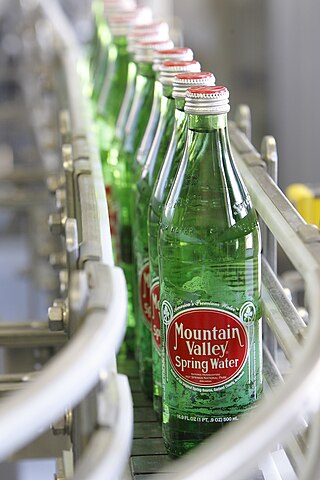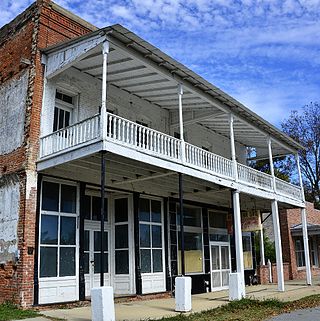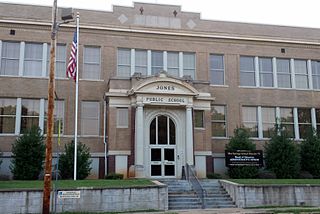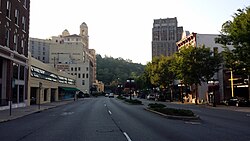
Scouting in Arkansas has a long history, from 1913 to the present day, serving thousands of youth in programs that suit the environment in which they live.

Hot Springs is a resort city in the state of Arkansas and the county seat of Garland County. The city is located in the Ouachita Mountains among the U.S. Interior Highlands, and is set among several natural hot springs for which the city is named. As of the 2020 United States Census, the city had a population of 37,930, making it the 11th most populous city in Arkansas.

Petit Jean State Park is a 3,471-acre (1,405 ha) park in Conway County, Arkansas managed by the Arkansas Department of Parks and Tourism. It is located atop Petit Jean Mountain adjacent to the Arkansas River in the area between the Ouachita Mountains and Ozark Plateaus.

Hot Springs National Park is an American national park in central Garland County, Arkansas, adjacent to the city of Hot Springs, the county seat. Hot Springs Reservation was initially created by an act of the United States Congress on April 20, 1832, to be preserved for future recreation. Established before the concept of a national park existed, it was the first time that land had been set aside by the federal government to preserve its use as an area for recreation. The hot spring water has been popularly believed for centuries to possess medicinal properties, and was a subject of legend among several Native American tribes. Following federal protection in 1832, the city developed into a successful spa town.

The Fairmont Banff Springs, formerly and commonly known as the Banff Springs Hotel, is a historic hotel located in Banff, Alberta, Canada. The entire town including the hotel, is situated in Banff National Park, a national park managed by Parks Canada. The hotel overlooks a valley towards Mount Rundle, both of which are situated within the Rocky Mountain mountain range. The hotel is located at an altitude of 1,414 metres (4,639 ft).

Bathhouse Row is a collection of bathhouses, associated buildings, and gardens located at Hot Springs National Park in the city of Hot Springs, Arkansas. The bathhouses were included in 1832 when the Federal Government took over four parcels of land to preserve 47 natural hot springs, their mineral waters which lack the sulphur odor of most hot springs, and their area of origin on the lower slopes of Hot Springs Mountain.

Munson Valley Historic District is the headquarters and main support area for Crater Lake National Park in southern Oregon. The National Park Service chose Munson Valley for the park headquarters because of its central location within the park. Because of the unique rustic architecture of the Munson Valley buildings and the surrounding park landscape, the area was listed as a historic district on the National Register of Historic Places (NRHP) in 1988. The district has eighteen contributing buildings, including the Crater Lake Superintendent's Residence which is a U.S. National Historic Landmark and separately listed on the NRHP. The district's NRHP listing was decreased in area in 1997.

The Medical Arts Building is a historic skyscraper at 236 Central Avenue in downtown Hot Springs, Arkansas. It is a 16-story structure with Art Deco styling, rising to a height of 180 feet (55 m). It was built in 1929 to a design by Almand & Stuck, and is the first skyscraper and was the tallest building in the state until 1960.

There are nine historic districts in Meridian, Mississippi. Each of these districts is listed on the National Register of Historic Places. One district, Meridian Downtown Historic District, is a combination of two older districts, Meridian Urban Center Historic District and Union Station Historic District. Many architectural styles are present in the districts, most from the late 19th century and early 20th century, including Queen Anne, Colonial Revival, Italianate, Art Deco, Late Victorian, and Bungalow.

Mountain Valley Spring Water is an American brand of spring water bottled in Hot Springs, Arkansas. It has been bottled continuously since 1871 and is currently owned by Primo Water. Mountain Valley Spring Water is distributed across the United States.

The Arkansas City Commercial District encompasses the three oldest surviving commercial buildings in Arkansas City, Arkansas. They are located along Sprague (4th) Avenue, between Kate Adams (1st) Street and De Soto Avenue, and are a reminder of a once-thriving commercial district in the city. The Cotham Drug Store, a two-story brick building from c. 1900, stands near the corner of Sprague and De Soto, facing south. The Red Star Grocery, built 1900, stands to its right; it is also a two-story brick building, but its facade has been altered, replacing a recessed doorway with a flush one. Stylistically the two buildings are similar, with brick corbelling and a course of dentil molding, with a parapet above. The third building is the Ramus Brothers Market, which stands on Sprague Street, and was built in 1910 out of poured concrete.

The Yell County Courthouse is a courthouse in Dardanelle, Arkansas, United States, one of two county seats of Yell County, built in 1914. It was listed on the National Register of Historic Places in 1992. The courthouse is the second building to serve the Dardanelle district of Yell County.

Washington–Willow Historic District is a residential neighborhood of Fayetteville, Arkansas containing over one hundred historically and architecturally significant homes. Styles range from those popular in the mid-19th century through present day, predominantly Victorian, Italianate, neoclassical, and craftsman bungalows. Historically, Fayetteville leaders in business, law and education have all called the district home. The homes sit at the foot of East Mountain within the Masonic Addition, the first addition platted following incorporation.

The Symes Hotel is a historic building in Hot Springs, Montana. It was built in Mission/Spanish Revival style during 1929–1930. It was listed on the National Register of Historic Places in 1998; the listing included 10 contributing buildings and one contributing structure. It has also been known as Symes Medical Springs and as Symes Medicine Springs.
Little Rock, Arkansas is home to numerous neighborhoods. See List of Little Rock Neighborhoods for an exhaustive list.

The Jones School is a historic school building at Linwood and Hobson Avenues in Hot Springs, Arkansas. It is a three-story masonry structure, finished in red and beige brick, with concrete trim elements. The building is an eclectic blend of Classical Revival and American craftsman styling, with Craftsman style window groupings and a Classical entrance portico. It was built in 1913, and now houses the Hot Springs School District administrative offices.

The Hot Spring County Courthouse is located at 210 Locust Street in Malvern, the county seat of Hot Spring County, Arkansas.

The Mountainaire Hotel Historic District encompasses a pair of former hotel buildings at 1100 Park Avenue in Hot Springs, Arkansas. They are virtually identical four story masonry structures, clad in a buff brick veneer, with stepped facades in an Art Moderne style. They were built about 1947, as part of a planned five-building complex, and are one a small number of Art Moderne buildings in the city. They were built by A.I. Albinson, originally from Minnesota, and operated as a hotel for about twenty years. They were thereafter converted to an elderly care facility. At the time they were listed on the National Register of Historic Places in 2004, the buildings stood vacant.

Eagar Townsite Historic District is a section of the town of Eagar, Arizona which has been designated a National Historic Place. Sitting on roughly 54 acres, the site contains 37 structures, 21 of which have historical significance. The period of significance is from 1886, the year the townsite was founded, through 1942, which represents the significant period of development of the town. The site was added to the Register on July 23, 1993.






















